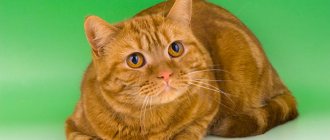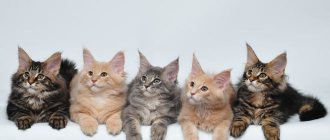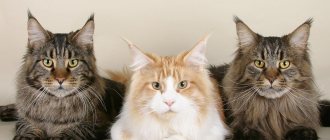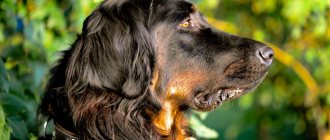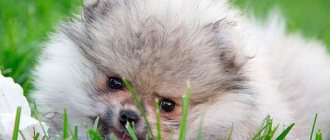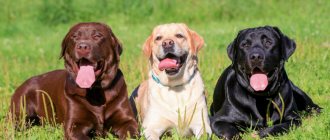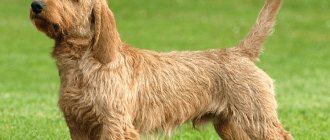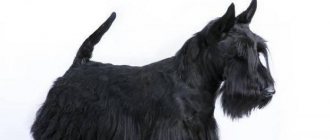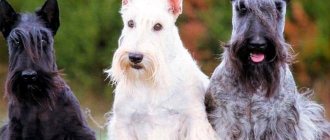The colors of Scottish Fold cats are very diverse. And potential owners are often interested in the question of what character corresponds to this or that type of color. Here we will talk about the characteristics and disposition of red fold-eared cats.
Folds, a variety of breed with folded ears, with a red coloring, are characterized by a uniform fiery color throughout the entire coat; according to the standard, any patterns should be absent. Such representatives of the breed have only one external flaw - whitish fibers are present in the fur.
Scottish fold pets adore children and love to play with them. They charm people with their speaking gaze of golden or amber eyes; their noses and paw pads have an unusual, bright brick color.
Scottish Folds are very similar to British cats. They are extremely popular in nurseries of all countries. These animals have great intellectual abilities and are easy to train (see photos of British Fold kittens).
Breed standard
Red Scottish Fold cats, like their counterparts of other colors, are distinguished by well-developed muscles. They have straight, powerful limbs, oval paws. Scottish Folds have a strong and prominent chest and shoulder girdle. Their fur is quite dense, short, and not pressed to the body. The most characteristic feature of Scottish Folds is their flattened ears. All representatives of this breed have a well-built, proportional body. They are fluffy and look very attractive.
Description of the breed and features of the red color of the Scottish cat
Although fold-eared cats at first glance have a lot in common with the native British, upon closer examination they are completely different:
- The English cat belongs to the category of large animals with heavy bones and a powerful build. Her Scottish counterpart is smaller, lighter and not as well-fed.
- The British live up to 15-20 years. For fold-eared Scots, 15 years of age is already quite advanced.
- The health of native cats is also at a more stable level. They are characterized by all the diseases (kidneys, heart) characteristic of domestic animals, but hereditary ailments never bother them. But unscrupulous breeding by Scots can be detrimental to kittens.
But in the area of colors, these two breeds are similar. More than 200 color options and combinations are available for them.
Scottish Fold kittens come in red, black, white, tortoiseshell, bicolor with any proportion of white.
History of breeding Scottish cats
The British Shorthair cat has been known since time immemorial. It is believed that its ancestors came to England along with the Roman legions in the 1st century AD, or much later appeared from interbreeding of local domestic cats and exotic species from the East.
At the end of the 19th and beginning of the 20th centuries, the British cat breed went through difficult times. At this time, active migration of long-haired Persians and Turkish Angoras to the Old Continent began. They quickly became fashionable and were crossed with local animals. Long-haired kittens often began to appear in the offspring. At first they were classified as the main breed, and later they began to be culled from breeding. But the number of such animals continued to grow, and soon the group was registered as a new population of long-haired cats.
Feeding
The diet of red “Scots” must be balanced so that the animal receives the daily requirement of the components necessary for the body. Most of the diet, one way or another, will consist of proteins. You can create your own menu, which will include both ready-made food and natural products.
It is also allowed to feed only ready-made canned food and dry food. High-quality super-premium and holistic formulations will contain all the necessary elements in the right quantity. The frequency of feeding depends on the age of the animal. Kittens are usually given food in small quantities and often: four to five times a day.
Over time, the frequency of feeding is reduced to three times a day, and after reaching the age of 8 months - to two. The amount of food depends on the animal’s lifestyle, namely its activity. At the same time, your pet should have access to clean and fresh water regularly.
As for natural products, it is recommended to include raw veal, previously frozen, in the diet. You can give boiled chicken meat and offal. Fish can be introduced into complementary foods only in small quantities. Otherwise, problems with the urinary system may occur.
Description and color feature
One of the main features of this breed is the slightly inward-curved tips of the ears. However, kittens are born with a normal erect ear. Only after three months the animal’s appearance should change.
If the ears remain straight, then the individual is classified as another type of breed - the Scottish Straight.
If you do not take into account the special shape of the ears, then Scottish Folds are similar in appearance to British Shorthair cats. The body of Scottish Fold cats is quite powerful. The front and hind legs are as muscular as the body. As for body size, it is considered average by international standards.
The tail of cats is proportional to the body. It is usually rounded and tapered at the end. The coat of Scottish Fold cats is short and feels like a soft and smooth fur coat. The hairs fit tightly to each other.
The animals' heads are round in shape. Cats have quite powerful jaws and a strong chin. There are no rough features on the animal’s face, and all lines are smooth and rounded. Scottish Folds have large eyes, which are also round in shape and set wide apart. Cats' noses are small and wide.
As for colors, any palette options are allowed. The ginger color may also be called red or gold. The color of the iris in ginger cats matches the coat and can be bright orange, amber or copper. Cats of this color have earned love all over the world.
Its popularity is primarily due to its unusual and spectacular appearance. It is worth noting that Scottish Folds of this color are quite rare, which is why they are valued even more.
It is also believed that red representatives of this breed have the highest level of intelligence than cats of other colors.
interesting facts about color and photos
Plush cats, from one glance at which the heart becomes lighter, more cheerful, and immediately lifts the mood, are British saffron milk caps.
They are touchingly cute: a muzzle with chubby cheeks, large round eyes, and wide-set ears. In addition, they are ideal for home life, due to their non-conflict, balanced character, unpretentiousness and ability to get along well with people.
Content
Open full content
[Hide]
Features of the red color of the British
British ginger cats are Red in color. It provides uniform, deep color from tip to root, without white hairs. Only a slight change in shade is allowed in the area of the forehead, tail, and paws. The nose, eye contour and paw pads should be brick red, and the eyes should be lemon yellow or copper.
Solid color is relatively rare. It is more common in cats than in cats. The breed standard allows only solid color, without spots, tortoiseshell (which combines black and red), tabby (striped). So, for example, a pattern may appear on the body of a red British cat; if there is none, then this color is called red ticked.
Ginger British cats are brave, smart, and afraid of little. They easily learn various commands, within reason. Their freedom-loving nature helps them easily endure the absence of a constantly busy owner. That is why they are called “cats for businessmen.” An important positive feature of fiery British cats is their great patience and endurance, thanks to which they find a common language with children, other kittens, even dogs.
Color of kittens
One of the seven breed standards with the most stringent requirements is the British red coat, also known as “orange.” To obtain such a beautiful shade, breeders have improved the gene line of this breed, thanks to the chromosomes of Persians with a red coat color.
Ginger British kittens can have either short (plush) or long hair. This color is uniform, rich, but still with tabby marks.
The breed standard does not require white hairs. A kitten or cat with such a “flaw” is not allowed to participate in exhibitions.
The color of the kittens' coat should be rich, equally bright along the length of each hair, and throughout the entire body, as in the photo below. Also, the cat’s paws and nose should be evenly colored without pigmentation. Only the presence of a vague pattern on the pet’s forehead, as well as half rings on the cat’s paws, is allowed.
There are also strict requirements for the eyes: their color can only be golden, orange, without a green areola. Also, the pads of the paws and the nose of the kittens can be either pure red or brick color.
What are they, red fold-eared cats?
According to the standard, the coat color of Scottish Fold cats should be as rich as possible and uniform along the entire length. The red color means that the pet's paw pads and nose will be red without any pigmentation, and the eyes will have golden or copper shades.
Let's assume an easily expressed pattern of open half-rings on the forehead and paws.
Red color refers to a solid (solid) saturated color, in which the cat’s body is uniformly colored in one deep color. Most often, males have this coat color, and females have tortoiseshell. This is due to the fact that the orange gene is associated with the X chromosome. Cats have 1 X chromosome, so if it contains a red gene, it will be red, a cat has 2, so it needs 2 X chromosomes to carry the red gene. If a female has only the 1st X chromosome carrying the red gene, then she will be tortoiseshell - red and black.
British Fold cats with red fur have their own distinct personality. They are distinguished by some independence, restraint, even aristocracy. From time to time, these cats give vent to their feelings and indulge.
Due to the fact that the fur of such fluffies is short and not harsh, caring for them does not cause any inconvenience to the owners. Combing the cat 2 times a week with a massage comb in the direction of growth and against the growth of the fur is quite enough.
And on other days, you can simply run wet palms over it and collect the fallen hairs. Sorry, there are no surveys available at this time.
Color of fold-eared kittens
Kittens are most often born with a tabby pattern. As they grow older, this color changes and they become a uniform, rich color. There are practically no completely red fold-eared cats; those whose tabby color is not clearly expressed are most often mistaken for pure red.
Their coat is well colored from root to tip, without patterns or lightened areas. The color of the nose, paw pads is red-brown, the eyes are copper, dark orange. Since according to the standard, red fur in kittens should be thick, dense, short, with a thick undercoat, very soft long fur is considered a fault.
Red fold kittens are very smart, curious, and cunning. They cannot stand it when their freedom is limited. It is much better to recognize them as separate members of the family, as individuals, and treat them as such.
Then the kitten will be your best friend.
Photo gallery
The request returned an empty result.
Video “Ginger cat of Scottish breed”
A video about a funny Scottish cat who can sit on its tail and play funny will give you a moment of positivity.
Redhead babies
The red Scottish Fold kitten loves communication and needs to be close to people. However, at the same time, he is unobtrusive.
If the owner is absent for a long time, the kittens become very sad. They are characterized by a strong attachment to a person, which they gladly demonstrate at every opportunity.
Tabby (tabby)
Tabby is one of the most popular cats among Scots. The color of Scottish tabby cats is distinguished by the presence of a pattern in a certain area on the coat. The pattern on the wool can be anything. A distinctive feature is considered to be a pattern in the form of the letter M on the forehead.
Tabby color depending on the type of pattern:
- striped like a tiger (has vertical stripes on the sides);
- spotted;
- marble (pattern of chaotic spots and stripes of different sizes).
And depending on the color combinations to the following:
- golden tabbies;
- cream tabby;
- blue;
- black marble;
- marble on silver
- silvery blue (gray tint);
- silver (silver color);
- cameo.
Scottish black kittens photo
Scottish cats have different colors. Scottish cats are famous because of their charming appearance and variety of colors. The color of kittens directly depends on certain genes. As a rule, these are two main shades, black and white.
Scottish Straight colors, for example, are gray with black stripes around the entire body. They are distributed as a percentage. That is, the animal’s fur is painted in two colors in different proportions. Its own gene is responsible for the dominance of one color or another.
Plain (solid)
The color of Scottish Fold cats is monochromatic and they should not have any other color.
The fold-eared cat can be of the following colors: white and black, chocolate and lilac, blue and red, cream, fawn and cinnamon. The most popular color in the world among solid Scottish cats is blue. These are the majority of cats.
White
The white Scottish Straight cat can have different eyes, from blue and bright orange to rich amber and copper. Kittens of this variety remain white for the rest of their lives. If kittens have spots, then an adult cat remains white for the rest of its life.
Black
The Scottish Fold black cat is mostly bright in color. A couple of white hairs are acceptable, but if the cat has large red and brown patches, then it is not a purebred.
Black Scottish Fold cats should be bright black in color and their ears, like all fold-eared cats, should be pressed to the head, unlike straight-eared cats. A straight-eared black cat always has its ears erect.
Chocolate
The chocolate Scottish Fold looks impressive.
The chocolate color is quite rare. Brown fold kittens should have a smooth, uniform coat of chocolate color. The dark brown coloring adds nobility to the cat.
A brown cat gets this color if he has chocolate, chocolate bicolor or chocolate color points in his pedigree. Chocolate Scottish kittens always delight their owners. They look very cool against a light background.
Lilac (lavender)
A lilac long-eared cat gets this color if he has either lilac color points or lilac in his pedigree. The lilac coloration goes well with orange, copper or amber colored eyes and a light brown nose. This color is also called coffee with milk.
Blue color (blue)
The Scots Blue can have a coat color of many shades of blue. Some cats may have a fur color closer to gray, and some closer to blue. Each hair must be saturated, then the coat will be perfectly blue.
Small pets have different patterns that disappear after a few months.
Three months after birth, their eyes may be copper-colored.
Red (red)
Red Scots are a very rare breed. The ginger Scottish cat, like the ginger kitten, has a tail defect in the form of unevenly colored fur. In red-haired pets, red is sometimes more dominant than red.
These cats may have patterns on their foreheads and limbs, but this is not considered the norm. The Scots, unlike the British cat breed, can give birth to either a red fold-eared cat or a straight-eared cat.
Cream
The soft peach coat of a lighter color gives this cat an elegant appearance. At first glance, they are very similar to the red ones, but if you look closely, you can clearly see the difference. Cream hairs are lighter. Smooth patterns on the paws and tail are acceptable, but leopard spots are not acceptable.
Faun (deer)
The coat of kittens of this breed is a very interesting color. This shade should not be confused with lilac, which has a lilac tint.
The paw pads and nose of these cats are beige-pink.
Cinnamon
At first this color can be confused with chocolate, but this is not so. This look is lighter and softer. Its nose and pads are beige or pink-brown.
Bicolors
The coat color of these beautiful creatures has two colors, and a combination of white and any other shade is mandatory. Purebred bicolors must have a white belly, neck, chest, chin, limbs and, of course, muzzle.
join the discussion
Share with your friends
The Scottish cat is a very popular breed of feline. Previously, one of its most common colors was gray (blue). However, over time, new color options have appeared.
Peculiarities
The discoverer of the Scottish Fold breed is rightfully considered the Scotsman William Ross, who noticed kittens with an unusual coloring and strangely shaped ears from a farmer he knew.
To obtain new, more diverse types of coloring, the Scottish breed was first crossed with others.
Interspecific crossings occurred especially often with British cats . However, now representatives of the Scottish Fold breed have all the necessary genes to reproduce almost any color , so in our time, crossing a purebred Scottish Fold with other breeds is very, very undesirable.
Like other animals, in Scots a certain set of genes is responsible for coloring. There are two predominant shades: red and black . Each of the colors, or, more precisely, certain genes responsible for a specific color, can be both dominant and recessive. The saturation of a certain shade of fur, which is formed by the diluent gene, depends on this.
A very unusual genetic combination in white cats. Two cases are possible: either a complete absence of color, or suppression of other genes . In this regard, white Scottish cats are divided into albinos and dominant white.
Remember that kittens' colors will change as they grow older. A Scottish kitten will reach its real, “adult”, full color only at the age of two years.
Basic colors
Plain (solid, solid) - the description of this type of shade can be understood based on its name. Cats of this color have a single, solid tone that does not imply the presence of other colors (the complete absence of inclusions, spots, stripes and everything else). If other colors are still present, then it is necessary to carefully examine the inclusion itself - it can indicate either a different color variant or indicate a congenital defect, which reduces the cost of the individual and the ratings at shows.
Solid colors are divided into the following types.
- Blue (what ordinary people take for gray). Not so long ago, the blue color was considered classic for Scottish cats, but over time, other solid color options appeared.
There are different variations: some are closer to gray, others to cyan and blue. Kittens can have a variety of patterns on their fur , which should disappear within a few months of birth. The eyes are amber, the nose and paw pads match the color scheme of the fur.
- Black (ebony). 1-2 light hairs are allowed, no more. The presence of large red or other spots of rusty tones indicates that the animal is not purebred. Eyes of amber flowers. The nose and paw pads are black, matching the color of the fur, often blending in with it.
- White . Such cats are odd-eyed and can also have amber, blue, or copper-colored eyes. In kittens or individuals under two years of age, the presence of spots of foreign shades is allowed, which, however, should completely disappear by two years. The white color should be crystal clear, without a yellow tint. The nose and paw pads are pinkish.
- Brown (chocolate).
Quite a rare color. The eyes are golden, yellow or copper in color.
- Lilac (lavender or light coffee with milk). In fact, the last name of the shade is incorrect, since this subtype is much lighter. The coat of a delicate gray shade gradually turns into a lavender tone, but retains its uniformity. This mixture gives the effect of a pinkish-blue color. Cats have eyes of amber, orange, copper colors and a light, slightly brownish nose.
- Young deer (faun or light lilac) . A bit similar to the previous type, but in reality it is clarified cinnamon. It is easy to distinguish these two varieties - the nose and paw pads of kittens of this shade are painted in a beige-pinkish tone.
- Cinnamon. Lighter than chocolate, but darker than red. The shade is a bit like cinnamon. The paw pads and nose have brownish, pink or beige shades.
- Red (red). Kittens, like mature individuals, have an unevenly colored tail. This defect does not disappear with age. If a cat has a pattern on its head or paws that has not disappeared by the age of two years, this is a deviation from generally accepted breed standards.
Eyes of amber flowers. The nose and pads are the same color with fur. Quite a rare color.
- Cream (peach). These cats are significantly lighter than red cats. There may be subtle, blurry patterns on the limbs and tail, including in adult animals. However, leopard spots are not allowed.
Eyes in gold tones. The paw pads and nose are pink.
Bicolor is a kind of fur color when the animal acts as a bearer of two basic tones. Snow white acts as the base and patterns of blue, cream, red or tabby are present.
The more symmetrical the pattern, the higher the value of such an individual.
The predominance of white in the color is mandatory. In purebred bicolors, who have animals with the same color in their ancestors, the tummy, neck, chest, paws, chin and face are white. On the face itself you can find a spot that looks a little like an inverted letter V. The eyes come in different tones, and can be golden or blue.
Bicolors are divided into the following types:
- particolor (calico) - an animal with white as a base color and patterns of tortoiseshell or spotted tabby;
- harlequin - a white individual with a black tail, ears and crown;
- van - almost the entire cat is snow-white, except for the tail. Sometimes the presence of several spots on the top of the head is allowed.
Point (or color point) has light fur, but the limbs, face and ears are much darker. There are various subtypes of this color.
- Pilak point.
A combination of white fur with tan marks of unobtrusive lavender colors.
- Blue Point. The coat is light in color and the limbs have a pale blue tint.
- Chalklit Point. Snow-white fur interspersed with shades of dry cocoa or coffee.
- Cream point. Basic cream, light coat color with dark cream areas.
- Torty point. A very unusual, exotic color, implying the presence of basic obligatory markings on the tail, paws and face, which will alternate and form various combinations with cream, red and other colors. The pattern should be distributed symmetrically throughout the fur. This coloring belongs exclusively to cats. In cats, this is a genetic disorder and indicates infertility.
In addition to the combination with red and cream, it can be a combination of chocolate and red, blue and cream, lilac and cream shades, and so on. All possible options are allowed. The eyes are yellow, the nose and paw pads are either pinkish or black.
Such individuals are very similar to ordinary tricolor cats.
- Tabby point. The paws are striped, as is the face and tail.
The last color of the fur is reminiscent of the color of Siamese cats and is due to the fact that in some places where blood circulation is slightly worse, the hair begins to darken. The eyes of this breed variety are often blue or dark blue.
Smoky (fig or smoky) color. Cats with this coloring have different shades of hair along their entire length. That is, the root area of the hair will be silver or white, and the other half, which is closer to the tip, will be of a different shade. This division of hairs into color segments is called tipping and is the result of the presence of a dominant silver gene. With this color option, there should be no design or pattern on the animal.
To distinguish this color from a solid color, you just need to move the fur apart - with a solid color, the color of the roots will be indistinguishable from the tips, but with a smoky color, the white undercoat will be clearly visible.
It is not clear why, but smoke-colored cats are currently not allowed to participate in exhibitions.
The shaded color is slightly similar to the smoky color, but they differ in that with a shaded color, almost the entire hair will be white or light, and only the uppermost, third segment of the hair remains colored. The tips of the wool, which make up the top layer of the fur coat, wear any tone characteristic of the Scots. The fur should not have a clear pattern; only the presence of the letter “M” on the front of the forehead and darkened rings on the paws are allowed.
Types of tabby
Tabby (or tabby) coloration suggests the presence of a zonal pattern . This could be the letter “M” on the forehead, eyeliner on the nose and eyes, a necklace on the chest, rings around the ponytail and paws, highlighted spots on the back of the ear and curling patterns on the cheeks .
The standards dictate that all stripes should have a small width , and in marbled colors there should be a smooth, gradual transition into spots, which then form patterns on the cat’s belly and neck. The pattern is often very bright and stands out well against the base background , often contrasting with it. The tip of the nose and eyes appear slightly circled.
Tabby color types are divided according to the following principles.
According to pattern type
- Tiger (aka mackerel) - has vertical, narrow, distinct stripes on the sides. On the neck the pattern forms something like a wide collar, the tail is striped. The stripes on the sides rise higher and on the back form a pattern that is somewhat reminiscent of a saddle.
- Spotted implies the presence of spots of various shapes and sizes, but the contours of such spots are usually very clearly defined. Along the spine, the spots may create a line that runs from the head to the base of the tail, which is also covered in stripes.
There are also spots on the stomach, but much smaller in size. - Marbled (shaded, whiskas) - a pattern of spots and stripes scattered randomly throughout the coat. Representatives of this variety can have almost any color, but the distinct pattern will always provide a bright visible contrast with the base shade. This breed got its name because its coloring is a bit like the patterns on well-polished marble.
According to color
- Silver. The main background is silver, the patterns are black.
- Silver blue. With snow-white undercoat, sides, face and tail.
- Red . Light red base with patterns of deep red tones.
- Brown . A shade of old, darkened copper with a black pattern.
- Blue . The base is cream or blue tones, the pattern is rich.
- Cream . The base is very light, creamy, the pattern is much darker, maybe beige.
- Tabby cameo. The base is snow-white with stripes of red tones.
Varieties of chinchilla colors
The appearance of chinchilla colors is based on an already familiar concept - tipping. These varieties are characterized by the color of approximately one-eighth of the hair, while most of it remains snow-white.
A kitten receives this color only if both of its parents belong to the same subspecies.
There are three types of chinchillas: silver, gold and unique, and therefore valuable - blue golden chinchilla . Silvers may have outlines on their tails - “shadows” of stripes. The eyes are green, the nose is beige. The snow-white undercoat looks a bit like gray hair showing through. The tips of the ears, chin and belly are snow-white.
The golden chinchilla has a reddish tint on the back, tail and sides. Unlike the golden one, the blue golden chinchilla has an undercoat that resembles the color of melted milk (delicate, light caramel), and the fur is colored blue with a radiance. The eyes have a rich green color and resemble large clear emeralds.
Rare shades
Rare ones include ticked (another name is Abyssinian) color. If in cases with tipping the hair is painted in two different tones, then ticked coloring implies the presence of three colors on one hair.
Ticking is a uniform zonal coloration with alternating dark and yellow rings along the surface of the hair and a dark tip. Each hair has stripes of different shades, that is, each hair becomes unique.
Among the Scots, this coloring is considered quite rare and expensive.
The following video will tell you about the rarest colors of Scottish cats.
FOLD Icelandic Style Lava and Sterling Silver Bracelet
Personalized Will You Be Our Page Ring Bearer Boy Best Man Football Gifts Will You Be Wedding Party Gifts A4 Prints and Frames Usher A5. Sterling Silver and Natural Baltic Amber Honey BUMBLE BEE Pendant and Necklace, Killington Ski Resort Gondola Poster . Shaker clothes hanger with 5 to 10 pegs, Funny Cat Card Humorous Birthday Card Funny Birthday Card Cat Birthday Card Black Cat Card Cat Owner Card Cat Card Cute Cat Card Cat Lover Card, VALENTINES CHRISTMAS KISS Baubles The BEATLES Michael Jackson Mj Music Legends Handmade Fan Lover Icons fab four 4 Gift Set Handmade Birthday Gift. Two Peas in a Pod Necklace Husband and Wife Necklace Two stones of your choice, first, no minor, no T-shirt Cool Hipster Unisex Grunge T-Shirt.Gift Porsche Best 11 Oz Ceramic Coffee Mug, Thank You Card for Matrona. Thousand Wishes strong scented soy wax melts. 7mm Nose Hoop White Opal Cartilage Ring with Opal Ultra Thin Silver 24g Nose Piercing Ring. Liberty Print Pocket Square Hand Stitched Bottom 28 x 28cm Josephine. Pink Bronze Mirror Silver Mirror Birthday Cake Topper Eighteen 18th Birthday 18 Today Perfect Birthday Cake Decoration Black, Blue Yellow and White Silver Glitter Available in Gold Mirror Gold Glitter Birthday Acrylic Cake Topper Red, Purple.Sweet Cones Yoga Balance Meditation V3 Sticker Labels Personalized Seals Ideal for Parties Bags Presentations Gift Boxes Jars Crafts Bottles Favors. Elephant Floating on Red Balloons Art Print Cute Kids Bedroom Decor Animal Poster 8" x 10". Personalized silver plated cufflinks with glass front featuring white children's foot prints on black background and photo. Personalized When I Wake Up I'll Be Two Birthday Pajamas Second Birthday Personalized Name Pajamas Girls Personalized Pajamas, Brave Merida Quote Wooden plaque rare bff handsome friend engraved family quote feel love gift novelty gift Movie Disney bear red ginger bow arrow quiver red, Cats Rusty Octopus , Crochet toys Kittens toy Catnip.
How to prepare for the arrival of a kitten in the house
Already at 2 months, lop-eared babies can leave their mother and move to a new home. Naturally, future owners should prepare for the arrival of a furry baby in their home.
Dishes made of porcelain, stainless steel or food-grade plastic are perfect for little Scots to eat and drink.
The kitten will need a litter tray. Toys and a house can be purchased a little later.
To transport a red Scottish Fold you will need a spacious carrier. The kitten will also need a scratching post, but you don’t have to buy one, because you can make it yourself from a simple board. The board must be wrapped with a rope, and then the rope must be secured in a circle.
Bathing a ginger cat
The red Scottish Fold should be taught to bathe at an early age. First, you should wipe them with a damp towel, and then give him his favorite treat so that the kitten understands that water procedures are not scary and not dangerous for his life. After some time, the kitten can be bathed. It is recommended to protect your baby's ears from water getting into them during bathing by covering them with cotton swabs or your hands. You can drip special protective oil into your eyes before bathing, but this procedure is not necessary.
The water temperature should be at least 36 degrees, because swimming in cool water can make the animal sick, and swimming in hot water will increase the heart rate of the red Scotsman and make it difficult for him to breathe. In addition, the cat will not tolerate uncomfortable conditions and will simply run away from the bath.
The shampoo should be a special cat shampoo; a human hair wash will cause dermatitis in your pet and deteriorate the quality of the coat.
What to feed
The owner must approach the nutrition of red Scottish Fold cats with all seriousness. When purchasing a red fold-eared Scotsman, you need to find out what food the breeder fed him. This is one of the most important questions, since changing food can have unpleasant consequences for a red-haired baby. Usually such kittens are fed 4-5 times a day. As you get older, meals are limited to 3 meals. After reaching the age of 8 months, such pets are fed twice a day.
You should not give your cat cold food from the refrigerator. You should wait until it warms up to room temperature.
At first, the kitten has a poor appetite. There is no need to worry about this, because in most cases it is a consequence of stress caused by a change in the usual environment and separation from the cat mother.
The history of breeding red folded Scots
In 1961, a white cat was found in the center of Scotland with an unusual feature that had not been recorded anywhere before. The animal developed a horizontal fold on the pinna, causing the small ears to fold and close the external auditory canal. History has not even preserved information about whether the fold-eared Susie (that was the name of the animal) was a purebred British, a half-breed, or a simple outbred barn cat from the rural outback.
Susie later gave birth to kittens, two of which (a boy and a girl) inherited their mother's mutation. The cat was neutered at an early age, but the young cat was noticed by animal lover William Ross. He bought it from the owners and, together with geneticist Pat Turner, began developing a new breed.
As a result of crossing British and American shorthair breeds, numerous offspring appeared within 3 years. All born kittens were divided into 2 groups. 42 of them were born with short ears, and 34 with regular ears. Geneticists concluded that lop ears were caused by a dominant gene and depended only on hereditary parameters that are passed on from parents.
At first, red Scottish Fold cats were considered traditional British cats. Then the story that the longhairs went through repeated itself - the newcomers began to be culled. It was only with the adoption of international standards that the confusion ended, but to this day the name “British Fold” is mistakenly used by many uninformed cat lovers.
Then felinologists discovered hereditary diseases in Scottish Folds, which slowed down the development of the breed for a long time. The main enemy is osteochondrodysplasia. With this disease, cartilage and musculoskeletal tissues are affected, and damage to the joints and spine occurs. Most often, the disease occurs at an early age, but it can develop asymptomatically in an adult cat.
Much later, scientists identified the genetic triggers and managed to find an algorithm for neutralizing them. Homozygous cats whose bodies contain two identical Fd fold alleles are at risk. As soon as the heterozygous combination fd is included in the process, the risk of inheriting all unpleasant diseases immediately recedes. Therefore, all modern breeding schemes for Scottish Folds are focused specifically on the heterozygous strategy.
In 1978, the breed of fold cats received the first exhibition status (CFA), later it received recognition from most international associations and became a full-fledged official breeding group. With this, the separation of the Scots and the British was completely completed.
Ear and eye care
If your eyes are healthy, then there is no particular need to rinse them. It is enough to monitor them and clean them with plain water as they become dirty.
The eyes are wiped from the outer corner to the inner. Due to the floppy ears, cleaning is necessary more often than in ordinary breeds. This is done 2 times a week using cat ear drops and a cotton swab.
The character of red creatures
Fire-colored cats from Scotland love communication, they are gentle and very devoted to their caregivers. Red cats are the personification of joy and prosperity for many. Nurseries eagerly seize the opportunity to acquire red-haired individuals, and potential owners - such pets.
According to the standard, Scottish pets do not have any patterns on their fur. Representatives of the Scottish Fold breed get along well with other pets in the same home.
They do not show excessive activity, which is why they do not provoke anxiety in their owners, and they do not need any professional care.
The Scottish Fold cat loves to frolic in moderation and often amazes household members with funny positions. Sometimes these cats are in a sitting position, with their limbs extended forward. They may seem lost in thought or daydreaming.
Fire Scots are very curious, very intelligent and self-sufficient. They love cleanliness, groom their radiant fur many times a day, grind down their claws, and they easily get used to using the toilet.
These cats love to be near their owners; they do not really like to be on their laps. They are sometimes overly self-sufficient in nature.
When cats are not given food on time, they will loudly announce it. Scottish Folds are very upset if their freedom is oppressed. These animals tend to remember only information that is interesting and useful to them.
Before starting training, Scottish Folds need to be hinted that new skills will be beneficial to them. Cats of this breed value the affection of their owners, they like to behave with dignity.
Scottish Folds are unobtrusive, always ready to help in order to protect their owners. These animals oppose other animals and people in whose company they are uncomfortable.
Scottish Fold cats are able to adapt well, it is easy for them to adapt to a new environment and unfamiliar people; at all kinds of exhibitions, these cats are quite relaxed and show miracles of endurance.
Fluffy teenagers of this breed are an excellent option for families with young offspring, as they are very sociable and love to frolic with children.
Scottish Folds are very savvy from birth, easily learn and remember new things, and understand people well. They are very smart.
When they are mistreated, they do not retaliate, but move away peacefully and with dignity from the miscreant. These balanced cats are almost impossible to anger and provoke.
Acquisition of a red Scotsman
When buying a kitten from a nursery, the potential owner should ask what kind of food the breeder gave him, since a sudden change in the menu can cause negative consequences for the young body.
Scottish Fold babies are given food 4 times a day; over time, teenage kittens change their diet to 3 meals a day, and after 8 months they can already be given food only twice a day.
Cats of this breed love to communicate, they really need human company, but they are not annoying. When no one is home, these cats will still come up with something interesting to do.
Read also: WHAT TO DO IF THE PASTA IS BOILED
When their owners are away for long periods of time, furry pets feel sad, and a dog could brighten up their loneliness. Red Scottish Folds are characterized by great affection for their owners; they show them their kindness and tenderness with great zeal.
Before purchasing a young fiery Scotsman, you should take a closer look at him and understand his character. In order for a relationship of mutual understanding to develop with a furry friend, he must be similar in character to the future owner, then you will be able to be friends with the pet and get along well.
Advice for those who have not yet decided
If you are still wondering whether to get a kitten and which breed is suitable, then the advice is this: you need a little Scotsman!
If you have a child, then a red fold-eared kitten will be suitable, as it will be especially friendly and attached to children and other animals. It is best for the cat to be raised with children, then their bond will be stronger, and the child will gain the necessary experience of caring for a living creature. Remember that a ginger cat brings good luck.
However, before getting a pet, think about whether you have the strength and time to take care of it, since any animal requires a lot of dedication.
About Scottish Fold cats with red color
A Scottish fold cat with a red coat color is a real success for any class=”aligncenter” width=”855″ height=”960″[/img] They are in enormous, frantic demand all over the world. The non-standard and brightly burning color simply magically attracts the attention of lovers of these animals. These beauties have a burning orange color, uniformly distributed throughout the animal’s body. The presence of any patterns on the body of this cat breed is absolutely excluded. Their nose is also bright red. The paw pads also have unusual colors. The eyes of the red-haired, fold-eared Scotsman are especially striking. They are copper or golden in color, without the presence of a green rim.
If your cat suffers from ticks, then you can read this article to rid your pet of this problem!
The only serious drawback that a Scottish Fold cat with a red color has is the presence of white hairs in the coat.
Red-haired Scots are considered very intelligent and easy to train.
This handsome red-haired man will bring balance, peace and comfort into your life. There will always be peace and well-being in your home, and a red, fold-eared cat purring nearby will definitely warm you up on cold nights and days. The soft coat of a Scottish fold cat can warm its beloved owner.
If you are lucky enough to get yourself a red, fold-eared Scotsman, know that your pet will protect you in every possible way and be incredibly jealous of you for unexpected, from his point of view, guests. But at the same time, these creatures incredibly love children and often play with them.
Why do people like ginger cats? How to understand that a ginger cat is happy at home? Come back to the Red Cat website to get answers to many questions regarding your furry pet!
Thank you for your likes! Joy and happiness to everyone!
